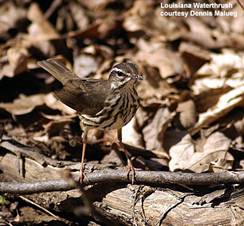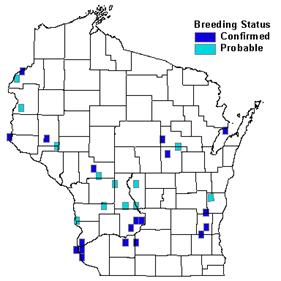Photo by Dennis Malueg


Status/Protection
- Global Rank: G5 Key to global and state ranks
- State Rank: S3B
- WBCI Priority: SGCN, State Special Concern
Population Information
Federal BBS information can be obtained at http://www.mbr-pwrc.usgs.gov/bbs/bbs.html by clicking on Trend Estimates and selecting the species in question. All estimates are for 1966-2005.
*Note: There are important deficiencies with these data. These results may be compromised by small sample size, low relative abundance on survey route, imprecise trends, and/or missing data. Caution should be used when evaluating this trend.
- Federal Breeding Bird Survey: significant increase
- Federal Breeding Bird Survey (WI): N/A
- Federal Breeding Bird Survey (BCR 23): non-significant decline*
- Federal Breeding Bird Survey (BCR 12): N/A
- WSO Checklist Project: decreasing (1983-2007)
Life History
- Breeding Range: Southeastern Minnesota south to Texas east to Atlantic Coast (Robinson 1995).
- Breeding Habitat: Northern Hardwood, Central Hardwood, Oak, Inland Open Water.
- Nest: Open cup nest within cavities, banks of streams, or under fallen logs.
- Nesting Dates: Eggs: early May to late June.
- Foraging: Ground and foliage glean, hawks.
- Migrant Status: Neotropical migrant.
- Habitat use during Migration: Similar to breeding habitat. Sometimes in other habitats, including parks, gardens, and thickets; generally associated with water.
- Arrival Dates: Mid-April to late May.
- Departure Dates: Early August to early October.
- Winter Range: Mexico through Central America and the Caribbean.
- Winter Habitat: Similar to breeding habitat. Most abundant along fast-flowing streams found in rough terrain.
Habitat Selection
The Louisiana Waterthrush inhabits mature deciduous, mixed floodplain, and swamp forests near swiftly flowing water (Hanowski et al. 2003). The presence of breeding Louisiana Waterthrush is an indicator of a habitat condition consisting of relatively pristine headwater streams in extensive unfragmented forests (Prosser and Brooks 1998). It prefers steep ravines along small brooks (Robbins 1991), where the water’s current rapidly flows over rocks. Disturbed second growth habitat and riparian corridors <10 meters wide usually are unsuitable for this species (Cutright 2006). Nests are located in small cavities along a stream bank, such as under an upturned tree or fallen log (Robinson 1995). The lack of foliage needed to construct and hide the nest allows this warbler to arrive and breed earlier than any other woodland warbler (Mossman and Lange 1982). The similar Northern Waterthrush breeds in more stagnant swamplands of northern and northwestern Wisconsin (Robbins 1991).
Habitat Availability
Good habitat for the Louisiana Waterthrush remains in the rough terrain of southwestern and western Wisconsin, where small streams run through large tracts of forests. It is believed to be more abundant in the Baraboo Hills than anywhere else in Wisconsin (Mossman and Lange1982), with up to 50 pairs of birds present in most years. A lobe in the northern distribution of the Louisiana Waterthrush extends into the St. Croix River valley in northwest Wisconsin (Mossman 1991). It also nests in Wyalusing State Park (Mossman and Hoffman 1989). Forests of other portions of the state, particularly more populated southern and eastern Wisconsin, lack several of the habitat characteristics most desired by this species (Robbins 1991).
Population Concerns
Breeding Bird Survey data suggest an increasing population trend range-wide for the Louisiana Waterthrush; however, BBS methodology may not adequately monitor this species (Sauer et al. 2005). Although certainly not a common species in Wisconsin, there are no data to indicate that its distribution has become limited over time (Robbins 1991). During the six-year period of the Wisconsin Breeding Bird Atlas (1995-2000), observers confirmed breeding in the following counties: Crawford, Dunn, Grant, Pierce, Sauk, and Waukesha (Cutright 2006).
Robbins et al. (1989) determined the Louisiana Waterthrush to be an area-sensitive species in Mid-Atlantic states. Thus, ongoing forest fragmentation in Wisconsin and across the Midwestern states is a valid threat (Robbins 1980, WDNR 2005). Furthermore, nests of Louisiana Waterthrush, particularly in fragmented forests, can have a high frequency of brood parasitism (Robinson 1995). Two instances of cowbird parasitism were observed during the Atlas (Cutright 2006). Fortunately, nests with one Brown-headed Cowbird young can still fledge host young (Robinson 1990 cited in Robinson 1995).
Recommended Management
Management for the Louisiana Waterthrush should focus on maintaining riparian systems, including natural vegetation and opportunities for nest sites (fallen streamside logs and stumps) within its breeding range. Because management recommendations for this species are sometimes at odds with trout, efforts are needed to balance the needs of both (WDNR 2005). Where Louisiana Waterthrushes occur, managers should consider retaining water in feeder streams at least until mid-June (Mossman and Lange 1982). Finally, methods for reducing forest fragmentation, which opens up riparian habitats to invasion by Brown-headed Cowbirds, are necessary. Conservation and management strategies for this species should be focused in the following Wisconsin ecological landscapes: Central Sand Plains, Forest Transition, Northwest Lowlands, Southeast Glacial Plains, Western Coulee and Ridges, and Western Prairie (WDNR 2005).
Research Needs
Breeding Bird Surveys occur after Louisiana Waterthrushes stop singing and often do not include riparian habitats, hence do not accurately monitor this species (Robinson 1995). Focused surveys, such as spot-mapping and point count surveys, are needed for more precise population estimates. The reproductive success of individuals subjected to differing intensities of cowbird parasitism needs study. Also, more study is needed on the ecology of this species in the wintering range (Robinson 1995).
Information Sources
- Birds of Forested Landscapes, Cornell Lab of Ornithology: http://birds.cornell.edu/bfl/speciesaccts/louwat.html
- Patuxent Bird Identification Center: http://www.mbr-pwrc.usgs.gov/id/framlst/i6760id.html
- Chequamegon National Forest Bird Survey (NRRI) species account: http://www.nrri.umn.edu/mnbirds/accounts/LOWAa2.htm
- North American Breeding Bird Survey: http://www.npwrc.usgs.gov
- Temple S.A., J.R. Cary, and R. Rolley. 1997. Wisconsin Birds: A Seasonal and Geographical Guide. Wisconsin Society of Ornithology and Wisconsin Department of Natural Resources, Madison, WI.
- Wisconsin Breeding Bird Atlas: http://www.uwgb.edu/birds/wbba/
References
- Cutright, N.J. 2006. Louisiana Waterthrush. In Atlas of the Breeding Birds of Wisconsin. (N.J. Cutright, B.R. Harriman, and R.W. Howe, eds.) The Wisconsin Society for Ornithology, Inc. 602pp.
- Hanowski, J., N. Danz, J. Lind, G. Niemi, and J. Sales. 2003. Birds of Western Great Lakes Forests. http://www.nrri.umn.edu/mnbirds/
- Mossman, M.J. 1991. Breeding birds of the St. Croix River, Wisconsin and Minnesota. Passenger Pigeon 53:39-77.
- Mossman, M.J., and R.M. Hoffman. 1989. Birds of southern Wisconsin upland forests. Passenger Pigeon 51:343-358.
- Mossman, M.J., and K.I. Lange. 1982. Breeding birds of the Baraboo Hills, Wisconsin: Their history, distribution and ecology. Wis. Dep. Nat. Resour. and Wis. Soc. Ornithol., Madison.
- Prosser, D.J. and R.P. Brooks. 1998. A verified habitat suitability index for the Louisiana Waterthrush. Journal of Field Ornithology 69(2):288-298.
- Robbins, C.S. 1980. Effect of forest fragmentation on breeding bird populations in the piedmont of the mid-Atlantic region. Atl. Nat. 33: 31-36.
- Robbins, C.S., D.K. Dawson, and B.A. Dowell. 1989. Habitat area requirements of breeding forest birds of the Middle Atlantic states. Wildl. Monogr. 103:1-34.
- Robbins, S.D., Jr. 1991. Wisconsin birdlife: Population and distribution past and present. Madison, WI: Univ. Wisconsin Press.
- Robinson, W.D. 1995. Louisiana Waterthrush. The Birds of North America, No. 151 (A. Poole and F. Gill, eds.). The Birds of North America, Inc., Philadelphia, PA.
- Sauer, J.R., J.E. Hines, and J. Fallon. 2005. The North American Breeding Bird Survey, Results and Analysis 1966 - 2005. Version 6.2.2006. USGS Patuxent Wildlife ResearchCenter, Laurel, MD.
- Wisconsin Department of Natural Resources (WDNR). 2005. Wisconsin’s Strategy for Wildlife Species of Greatest Conservation Need. Madison, WI.
Contact Information
- Compiler: Tom Klubertanz, tklubert@uwc.edu
- Editors: Rick Anderson, Rick.Anderson@co.clark.wi.us | Kim Kreitinger, K.Kreitinger@gmail.com
